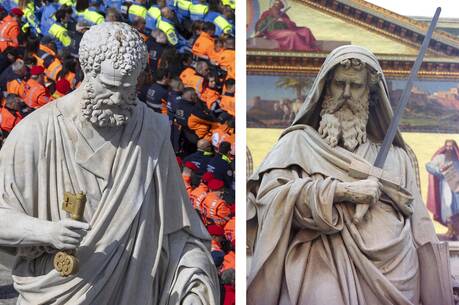A Shifting Rock
If there is one Scripture passage that seems to define Catholicism, it is the Petrine promise of Mt. 16:16-20. Matthew supplements Peter’s confession that Jesus is the Christ (Mk. 8:29) by the more solemn affirmation, “You are the Christ, the Son of the living God” and adds extraordinary statements about Peter. He is “blessed” because he, like the little ones of Mt. 11:25, has been gifted with divine revelation. And he receives a new mission symbolized by a change of name, Cephas becoming Peter, the rock (petros) on which Jesus will build his church, which the power of evil (“gates of the underworld”) can not surmount. Like the steward Eliakim in Isaiah, who receives symbols of power and the key of the house of David, Peter will receive the keys of the kingdom and be given the power to bind and to loose, which will be ratified in heaven. Somewhat paradoxically, having altered Mark to enhance the role of Peter, Matthew leaves virtually intact the subsequent misunderstanding by Peter, whom Jesus rebukes as a “Satan” who “is not thinking as God does, but as humans do.” Matthew also brackets the Petrine blessing and promise with two special additions, in which Jesus rescues a presumptuous Peter from drowning (14:28-32) and teaches an obtuse Peter about the freedom of the sons of the kingdom (17:24-27).
Throughout history this Petrine promise has been interpreted in different ways. In Matthew, Peter is the model disciple who must be constantly sustained by Christ. In the early church he is remembered primarily as an Apostle and martyr. Very early comes the typological interpretation, the “mother” of the other interpretations: Peter is the type of every true, spiritual Christian on whom the church is built (Origen’s commentary on Mt. 12:10). The “Eastern” interpretation is that the rock is the faith of Peter, so that the church is built on the faith of believing Christians; and strong in the Middle Ages is the Christological interpretation, according to which Christ is the rock (see 1 Cor. 3:11, 10:4). Still another interpretation, which dates from the fourth century, is sometimes called the Roman/pontifical interpretation: The rock is Peter, and the promises made to Peter apply also to Peter’s successors in the Petrine ministry. Since Vatican I this has been the normative interpretation for Roman Catholics. Fundamental to all interpretations and to the Johannine version of the Petrine promise (Jn. 21:15:19) are Jesus’ words that the church is my church and the sheep my sheep. Ultimately faith rests on Christ, who is the good shepherd of the flock.
Since Vatican I, the papacy has achieved an authority and influence never before seen in church history, which, in an often chaotic century, has offered a prophetic voice against evil and injustice and fostered the unity and spread of the church—often, though, at the price of unproductive centralization. While the influence of Mt. 16:13-20 is clear in the exercise of the papal office, it is difficult to see how Mt. 18:18, where the power to bind and loose is given to the whole church, has shaped the episcopacy and wider community of disciples. Still, ecumenical dialogues with both the traditional churches of the East and those stemming from the Reformation are now exploring ways a Petrine ministry might function in a renewed church. In his encyclical on ecumenism (Ut Unum Sint, 1995), Pope John Paul II notes challenges arising from the Petrine office and asks Orthodox and Protestants to join with him to envision the kind of papacy that could serve Christian unity in the future. This new vision may be shaped by courageous voices from the margin, not unlike that of the “Canaanite woman.”
This article also appeared in print, under the headline “A Shifting Rock,” in the August 12, 2002, issue.







